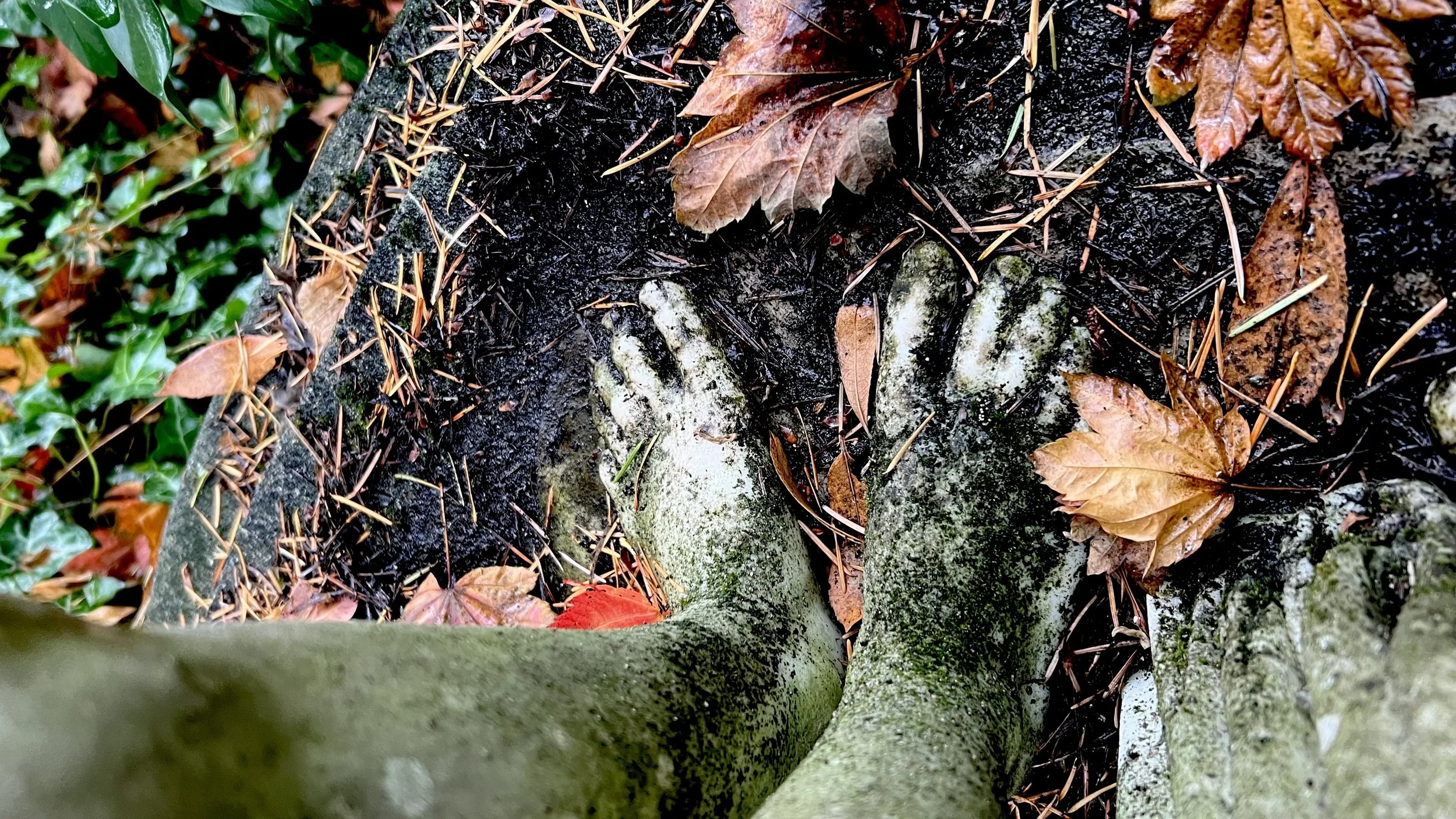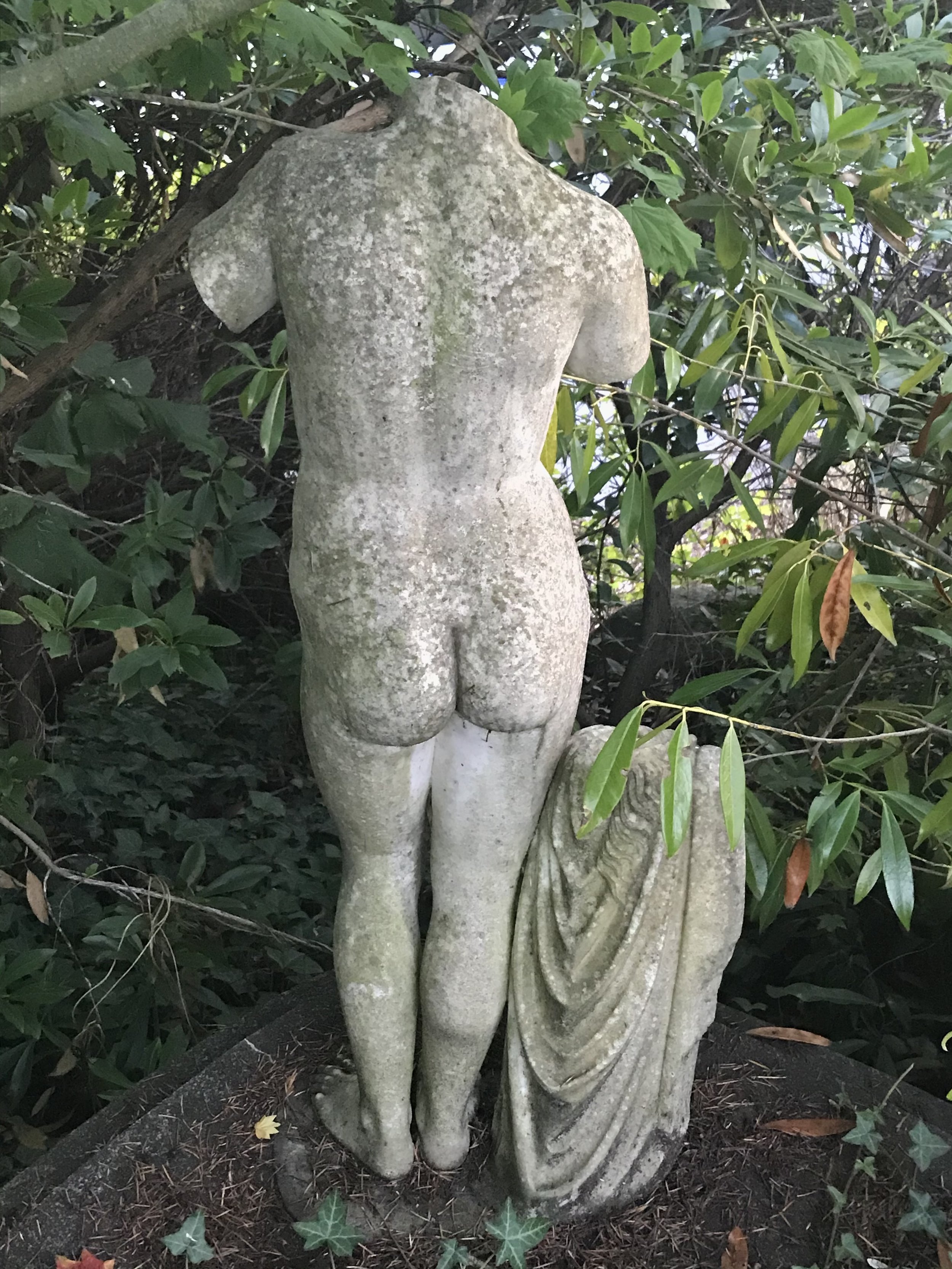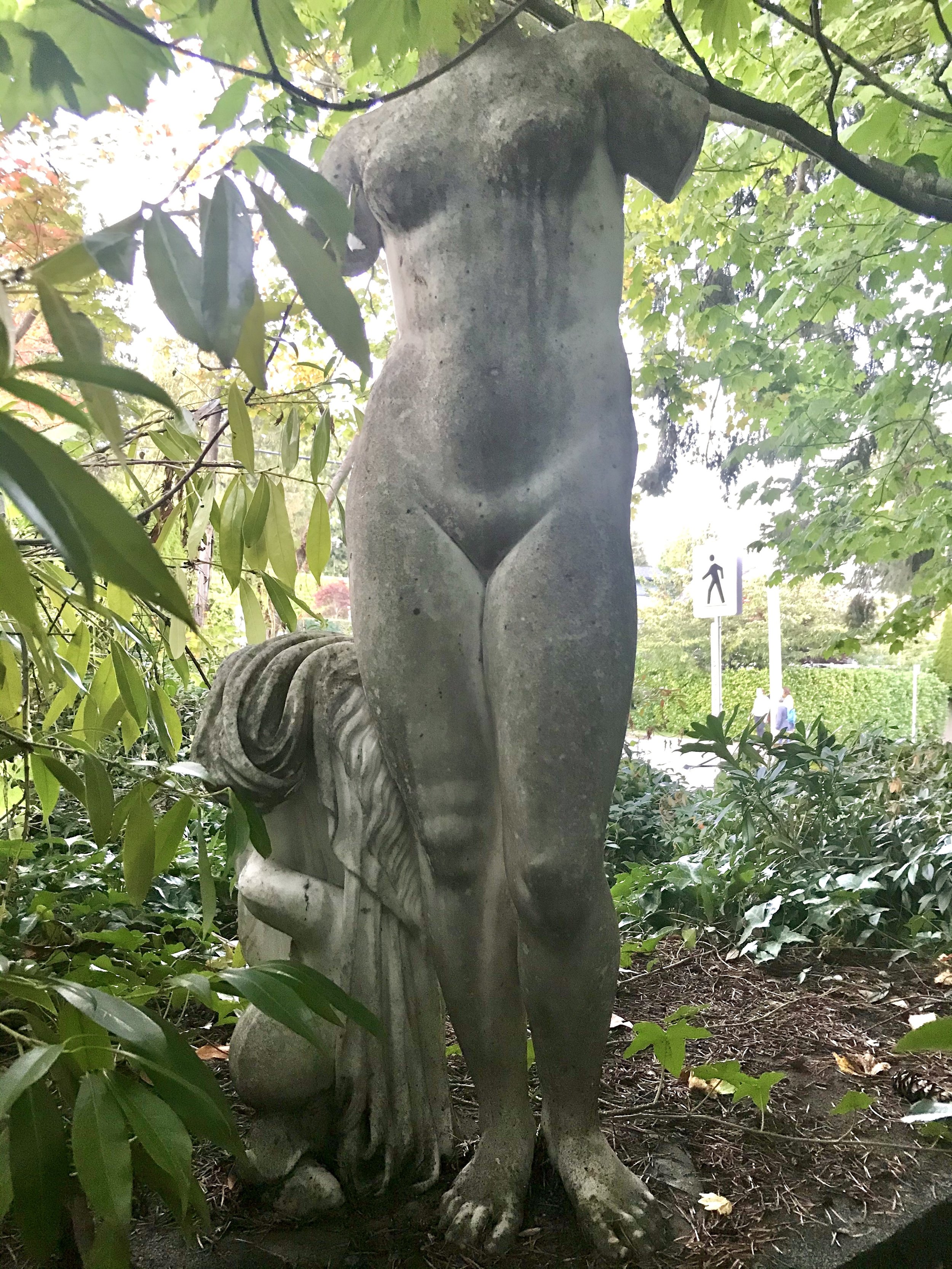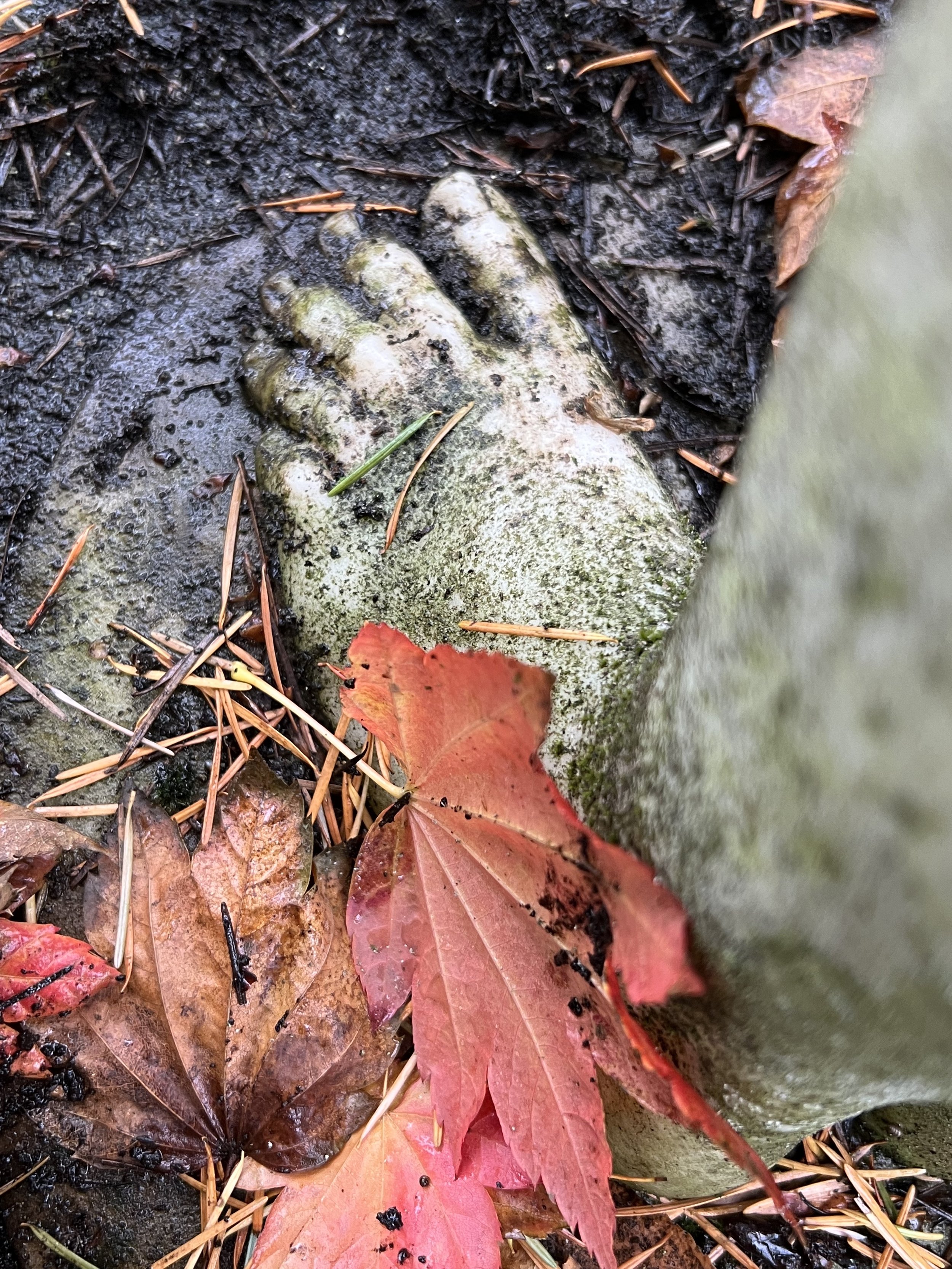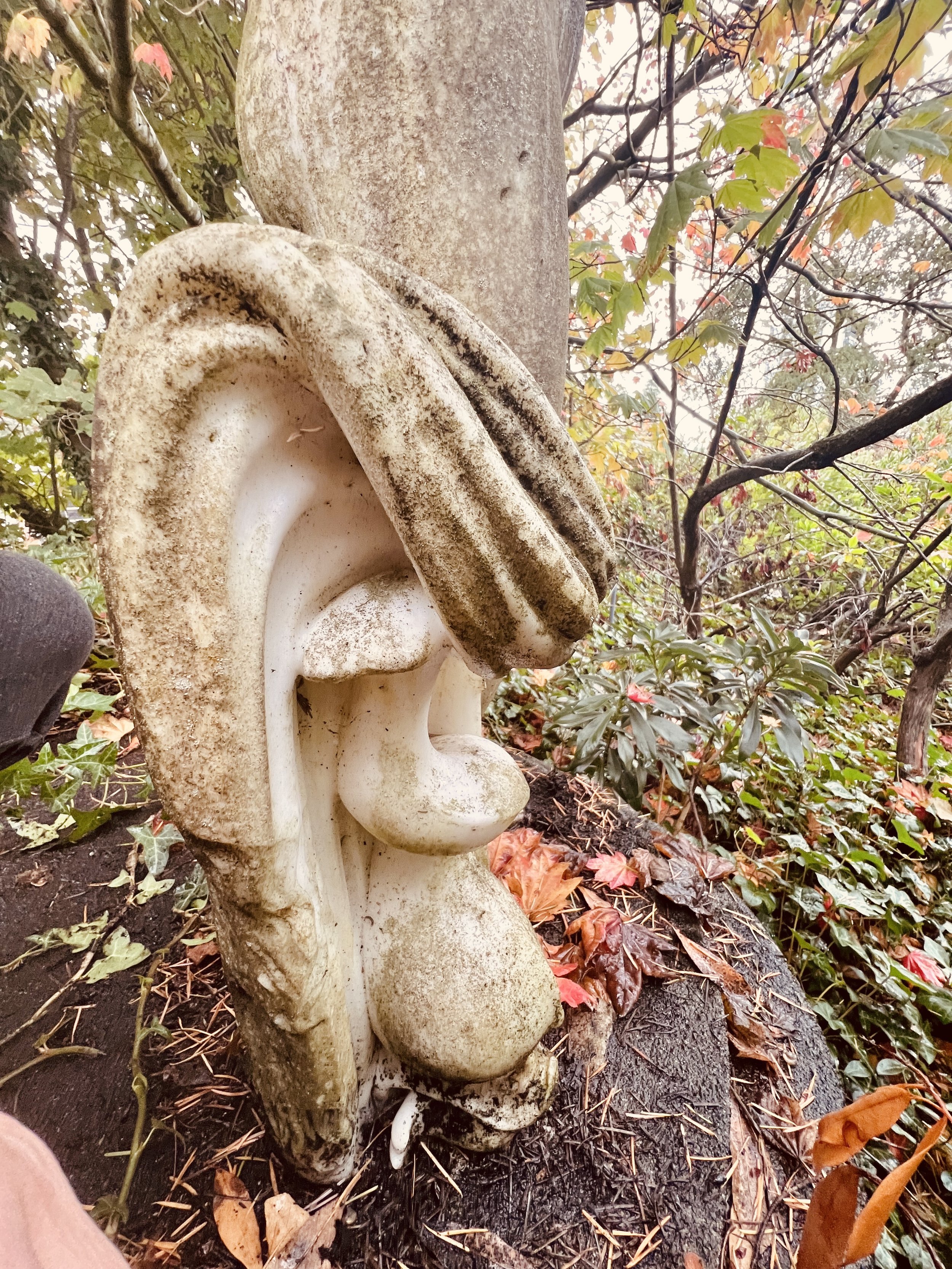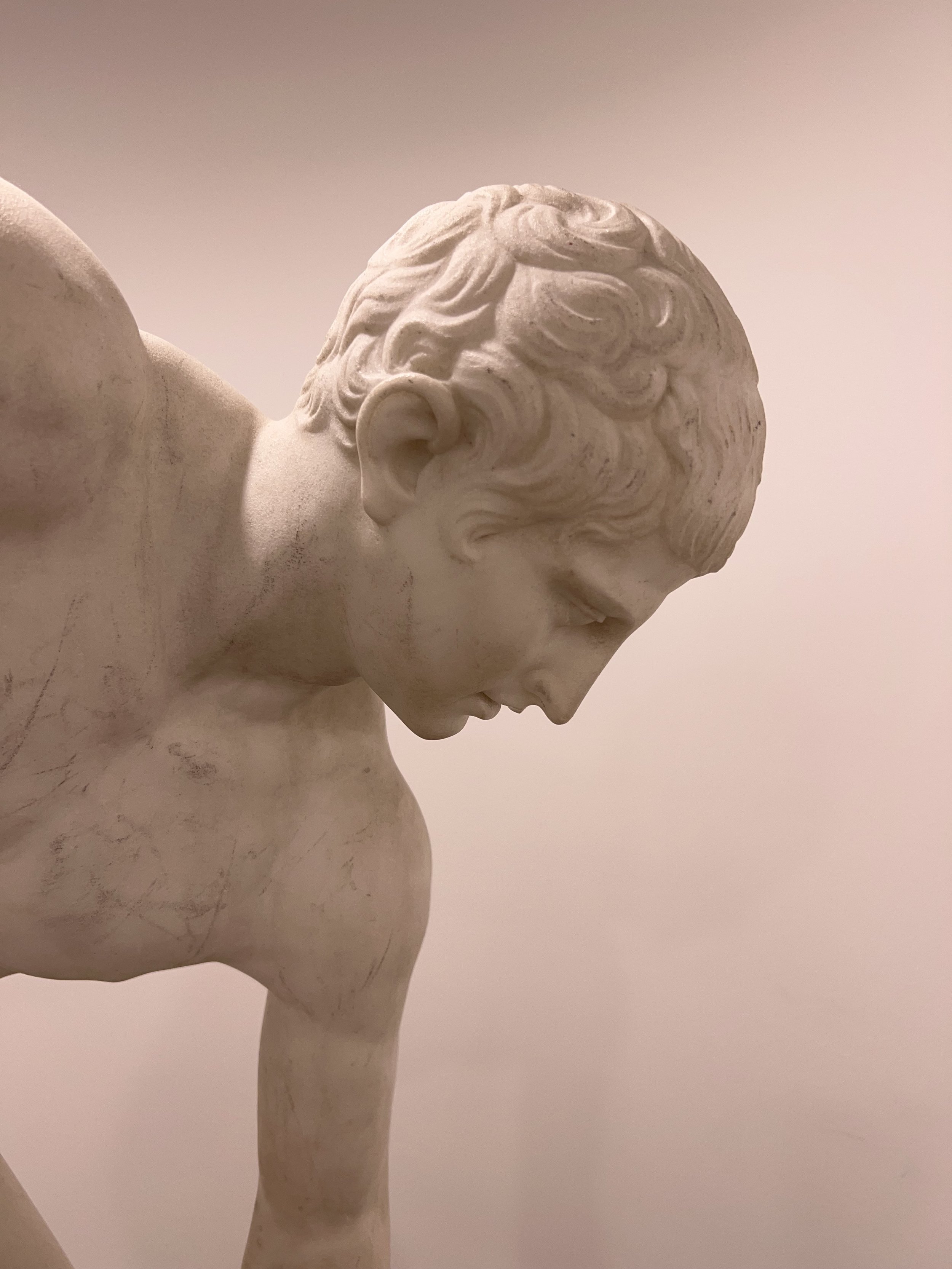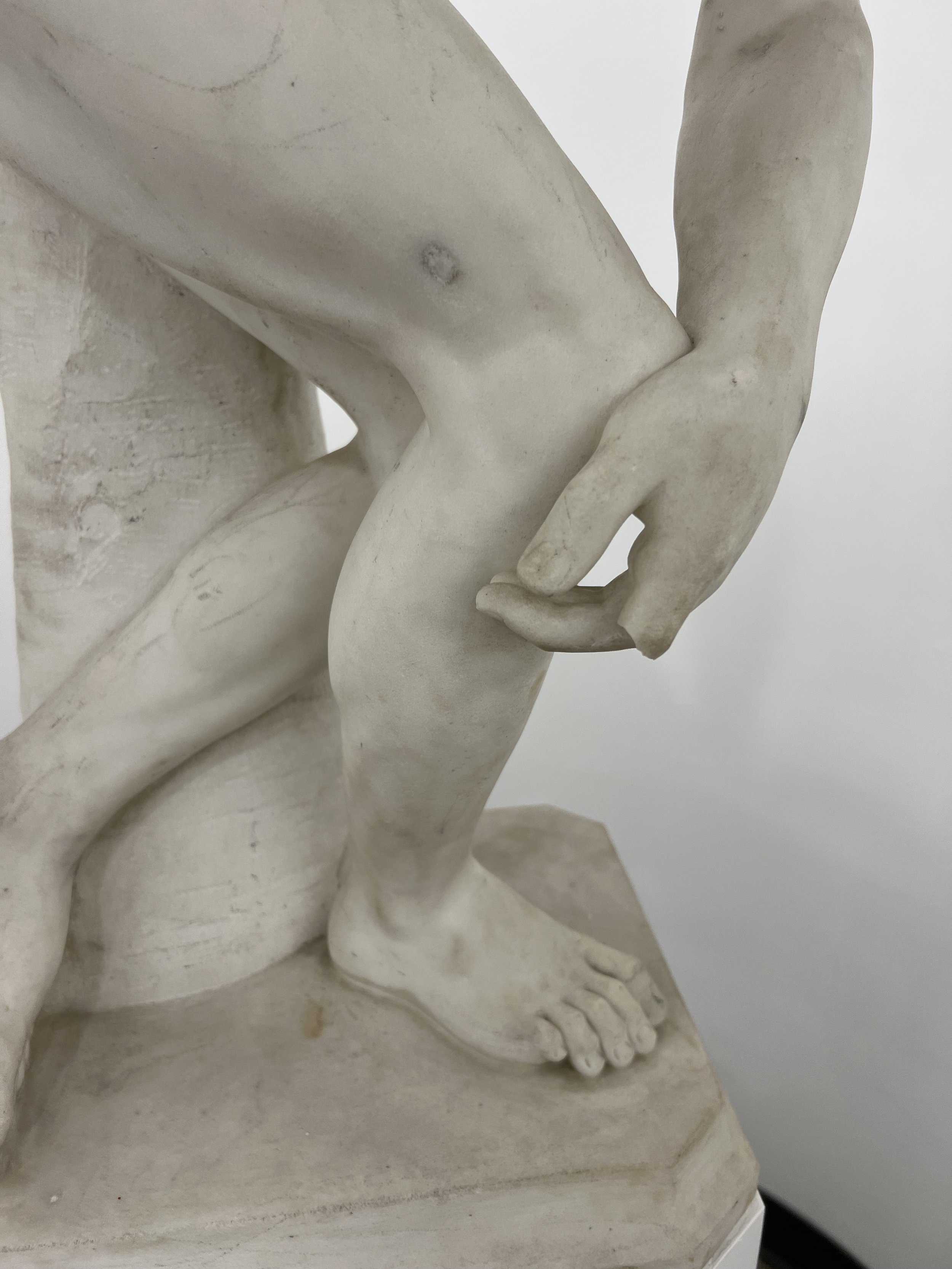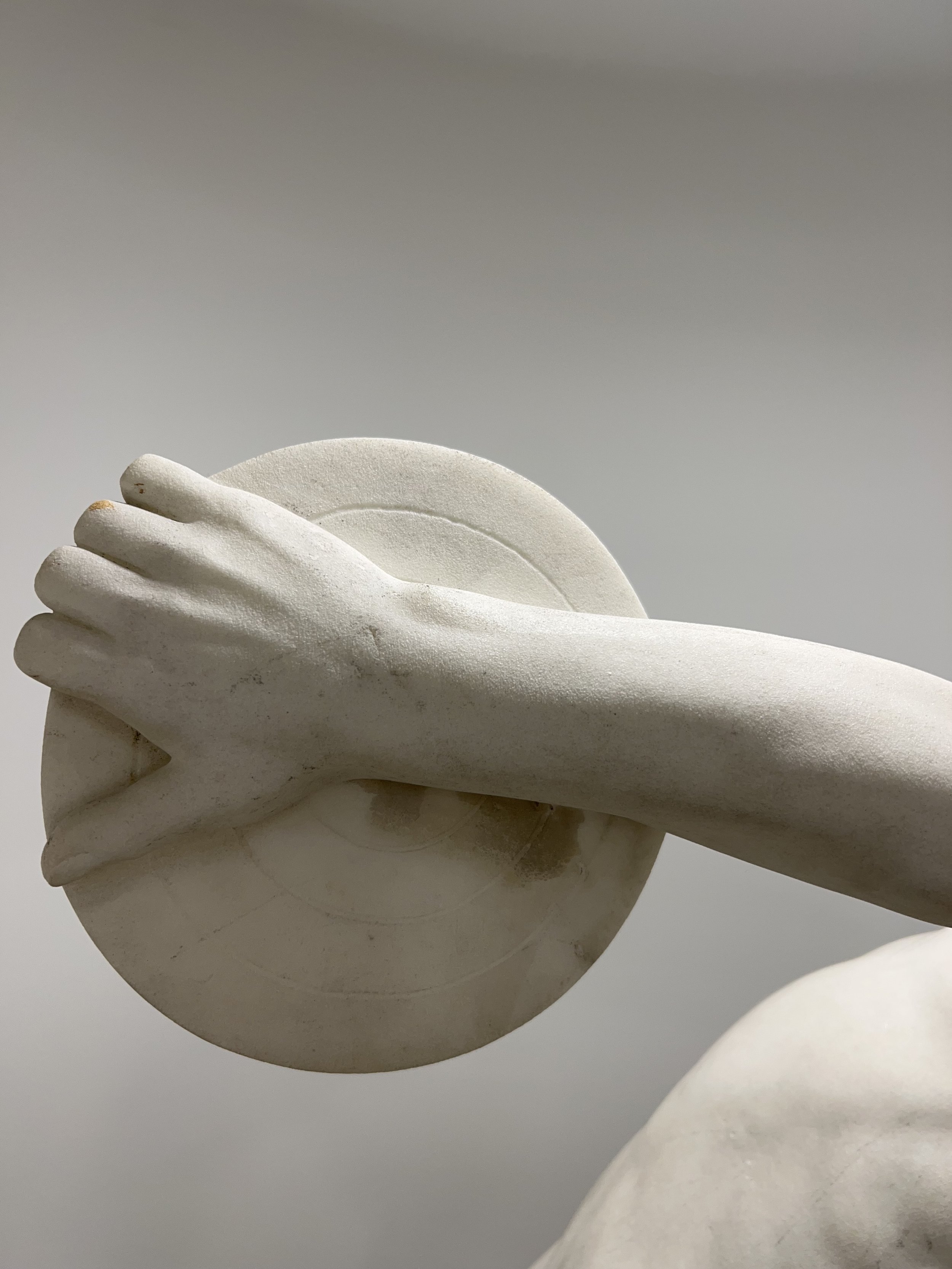If you’ve ever parked at the West Vancouver Municipal Hall in the parking lot by 16th St. and Fulton Ave or driven by on Fulton and missed the beautiful marble statue carved in a Classical Greek style, you’re not alone. The landscaping on the corner of the parking lot has grown over and around the statue and this ‘Marble Lady’ seems to have been forgotten to the mists of time. I was first told about this statue a couple of years ago by Laura Anderson, president of the West Vancouver Historical Society, who knew it was there and asked me to take some photos to document it for the Society. If Laura hadn’t told me about it, I likely wouldn’t have noticed it, either. In order to take photos, I had to go on a bit of an adventure through the thick, overgrown rhododendrons and bushes to even see the statue from the front. I hoped no one noticed me while I was doing this as I must have looked like I was up to no good!
The top two photos were taken around two years ago, and this one, just this week. The platform is completely ivy covered now and, not only was there a lot of moss and lichen growing on the statue, but the ivy had actually begun to adhere right to the marble. I had to gingerly pull it off so it wouldn’t grow further. I cleared the platform to look for a plaque or any other information but found nothing except for the statue’s buried feet.
Below left is a close-up of the statue’s foot and to the right a secondary part to the statue of what looks like a toga draped on a mythical snake.
Photos above by Jenny Morgan
I sent Laura the photos and honestly didn’t look further into it at the time until I, for some reason, thought about it the other day as a topic for a post. I had no idea what a research adventure would unfold! After coming up empty on my online searches, I wrote to Laura who suggested I contact the staff at the West Vancouver Archives. Thanks to its very helpful archivist, Reto Tschan, who found a transcription of a taped interview from the 199os of a West Vancouver Parks staff member who was in charge of landscaping the lot of what was, in 1964, the brand new and very modern Municipal Hall, I had the starting point I needed.
I learned a lot from the transcribed interview from December of 1999 of Heinz Berger, who started work as Assistant Superintendent and Municipal Landscape architect in 1961. He talks about how he was hired to landscape the new Hall, designed by the architectural firm, Toby Russell Buckwell, in a way that would soften the contrast between the very modern building and the modest, older homes across the street to the north. In his own words, Berger says “The building was very, very modern at the time and on the north side there are some new houses now but at that time there were more or less more simple houses. Nothing wrong with them but there was a clash between the very modern structure over powering these small homes. So when we made the plan we decided to make a berm and plant it very tight so that there was a separation.” The berm is still there, although it’s currently quite overgrown in many places. At the time, landscaping around parking areas to ensure that there was screening between the parking lot and the road was part of a Municipal bylaw.
Berger talks often about the budget being tight for projects and how he had to be innovative about where he got materials. The rhododendrons that were planted on the berm were all taken from houses that were being torn down. The pines that are still there and now overshadow the rhododendrons were planted because he could get them free from the Provincial Government. A reflecting pool was put on the NE corner of the parking lot on the berm ( it was eventually filled in and planted over) and a platform built next to it for a statue. He had a sculptor in mind to hire to fill the spot but the mayor’s wife at the time had her own sculptor she wanted to use. She said she’d fundraise for it, but in the end, she didn’t follow through, and no sculpture was made for the spot. The statue’s platform remained vacant for about a decade.
However, in the early 1970s, there was a lot of activity in Eagle Harbour at the large estate of Vancouver businessman, Nick Kogos. Before I get to explaining that activity and what it has to do with our Marble Lady, I should give you some background on Kogos. A Greek immigrant in the early 20th c, Kogos was a well-known and fascinating figure in the Vancouver business community.
By 1920 he was setting up his 17th restaurant, called the Broadway Cafe, which was called by the Vancouver Sun “most pretentious”, however I think this was a compliment, as the newspaper goes on to describe in great detail how fancy and wonderful the cafe was. Kogos was ambitious and imaginative, but also no stranger to criminal charges over the years. Shortly after Broadway Cafe opened, Kogo’s last restaurant was burned to the ground. He and a couple other men were charged with arson. The rumour at the time was that Kogos had hoped his clientele from the last restaurant would follow him, but they didn’t, so he burned it down. An unusual cause for arson, if that was the truth, as it’s most often for insurance money. Kogos got out on bail and continued to run the restaurant which eventually saw success. By 1930, Kogos decided to get into the club scene and became the first owner (along with Johnny Dillias) and long-time manager of the Commodore Ballroom, at the time called “The Commodore Supper Club.” He got into trouble here, as well, as, according to newspapers at the time, he had a hard time disappointing customers and tended to go over noise curfew times. Police had to come and kick everyone out as the band played on far too long and Kogos ended up in court, as I believe that wasn’t the first time. However, he did help make a name for the Commodore and ran it successfully for many years as a dinner and dancing club.
Kogos was proud of his Greek heritage and was heavily involved in the Greek community in Vancouver. He and his wife were known as philanthropists and Kogos would often fundraise through his businesses to help fellow Greek-Canadians in need. He decided to honour his heritage in a big way by buying a waterfront acreage in Eagle Harbour, West Vancouver, and building ancient Greek-style retaining walls, terraced gardens, a beautiful home and, the icing on the cake, a smaller scale replica of the Parthenon in Greece, right at the cliff’s edge. The story goes that he built the Parthenon for his wife, Sophia, who missed their homeland. Although I couldn’t find concrete evidence of this, I’m going with it, as I’m a romantic at heart!
View from the edge of the retaining wall at Nick Kogos' home under construction. Looking west you see the Parthenon as well as some of the statuary. West Vancouver Memorial Library has one statue on the Main Floor. Marble was imported from Greece for the statues and building. 1960
Courtesy of West Vancouver Memorial Library, 1501-WVML
Item is a photograph of the replica Parthenon designed by Nick Kogas and placed on his estate in Eagle Harbour. The replica of Athena Parthenos is at centre. The structure was dismantled and the sculptures removed from the property, subsequent to its sale and subdivision in the 1970s.
Courtesy of West Vancouver Archives. Photographer and copyright undetermined. 3431.WVA.PHO
This black and white photo taken possibly from the air in Eagle Harbour really shows off the structure of the Parthenon with its contrast.
Courtesy of the Province, July 3rd, 1966 and newspapers.com
The Parthenon took around 20 years to build, from the mid-1940’s to the mid 1960’s. The marble was sourced from Greece for the building and Kogos himself said that he spent that 20 years collecting the statues for it. What’s unclear is if he found these statues already made or if he commissioned them for the site. Some are carved from marble, and one, for certain, is a casting made from an aggregate that included marble. If they weren’t commissioned, it’s possible that they were already antiques when he bought them. I couldn’t find any information specifically on the age or origin of the statues.
Some of the them were huge and larger than life-size, some were closer to life-size and some very small, only a few feet tall.
The Parthenon became a tourist attraction for both people visiting it from the estate itself on the cliff, and for those passing by in Eagle Harbour in boats and aircraft. It was well-known both for being beautiful and an oddity. There was nothing else like it on Vancouver’s coastline. It was relatively short-lived, unfortunately. This brings us back to the activity in Eagle Harbour. By the 1970s, Kogos put the property up for sale. I’m not sure why he didn’t sell it as is, as it took 20 years to build and was very beautiful, but the Parthenon structure was dismantled. This must have been quite the sight! Kogos said he wanted to donate eight of the statues to West Vancouver. This was a generous notion, but not an easy one, in a way, for the District of West Vancouver, as the statues needed to be placed somewhere and looked after.
Here’s where the story returns to Heinz Berger, as he was called upon to take care of finding homes for and moving a number of these statues. He chose to move four of them to the Municipal Hall he was landscaping at the time. The statues were named “Grape Bust”, “Flower Bust”, “Statue of Nude Woman” and “The Wrestlers”. I don’t know the size of the two busts, but apparently The Wrestlers sculpture was large and very heavy. The only way to move it to the Hall was by helicopter. This was quite the scene, as a helicopter was hired by Berger to pick up the sculpture from the cliffside and bring it to the Hall, apparently landing right on the roof of the building!
Item is a photograph of the statue "The Wrestlers" being delivered by helicopter to Municipal Hall. The statue, a modern copy of a Roman copy, now in the Uffizi Gallery in Florence, of a lost Greek original, was one of the statues previously on display in Nick Kogos's replica Parthenon.
Courtesy of West Vancouver Archives. Photographer and copyright ownership undetermined. 3856.WVA.PHO
Item is a photograph of the marble sculpture The Wrestlers. Formerly on display at Nick Kogos's replica Parthenon and at Municipal Hall.
Inscription reads: “The Wrestlers” a copy of 3rd century (BC) statuary was removed from the Parthenon at Eagle Harbour and placed here by helicopter 14 July 1976
Courtesy of West Vancouver Archives. 2585-03-01.103.11.DWV. Creator is District of West Vancouver Planning Department.
Berger talks in his interview about the difficulty of constantly sealing the statues and protecting them from the elements as well as vandalism. One statue, which he doesn’t name, lost some fingers and an arm to vandalism which he eventually had repaired by a local expert. ‘The Wrestlers’ were eventually moved inside the Hall, but at some point were moved into storage.
And, as you’ve probably guessed by now, the ‘Nude Woman’ statue was the one that ended up on the platform. She must have looked beautiful when she was newer and next to a reflecting pool. She is only about 3 feet tall, but carved so finely and realistically that the photos I took of her feet look like a live human’s feet, albeit in a smaller scale. Berger makes no mention of her, but there was a January 11, 2011, article in the North Shore News that found the information somewhere about all the statues and their names, and mentions that the two busts and ‘Nude Woman’ were still at the Hall at the time. I made a search of the property, but either they are gone or they are in one of the areas around the parking hidden under large bushes. Only the Marble Lady (as I like to call her) seems to remain. She seems quite forgotten as the overgrown foliage, ivy growing on her and a dark hue of lichen and dirt seems to show. When I asked the front desk staff at the Hall about who is looking after her, they didn’t even know that she existed. It made me wonder if staff there didn’t know about her, then likely most people on the North Shore didn’t, either, and that’s a shame as she’s part of such a fascinating piece of North Shore history as well as being a beautiful piece of art.
And what of the other sculptures of the eight? Thanks to the North Shore News and their list of statues and resting places, I tracked down the only statue currently in the public eye that’s housed inside and being looked after. It’s ‘Diskobolos’, a cast marble aggregate figure of a discus player. It’s very finely made with very realistic features like the Marble Lady and has a nice home inside the West Vancouver Memorial Library. It’s story, however, also doesn’t seem to be well known, as the library staff didn’t seem to know about its history or what I meant when I asked about the statue brought from the old Parthenon in Eagle Harbour.
Photos above of ‘Diskobolos’ by Jenny Morgan
My next stop was The Silk Purse Gallery in Ambleside because, in 2011, there had still been a ‘Venus’ statue on display. I asked a staff member about it and he told me he thought it had been moved at some point into storage, and it was no longer at the gallery. I told him about my article and how I was trying to track down as many of the Parthenon statues as I could, and he told me about the online directory of public art that was on the District of West Vancouver’s website. I went to it to learn more about the other statues, including the Marble Lady, but the only one that was listed from the Parthenon was Discopolous. Others may be not listed because they are in storage, and not in the public eye, but the Marble Lady is still in the public eye, albeit not easy to spot. This made me realise even more how much she’s been forgotten.
Apparently an ‘Aphrodite’ sculpture ended up in storage with ‘The Wrestler’, according to the NSN article. The 8th statue was one called ‘The Bather’. It was put into the atrium of the West Vancouver Senior’s Centre in the 1970s. Heinz Berger expressed some trepidation in his interview about this statue as he had heard that the Centre was closing-in the Atrium for a renovation and would be moving the statue outside. He thought it could spell the end for it if it went outside. He was right. In Dec. of 2011, The Bather was severely vandalised. The head was cut off and it was left in pieces for weeks in the garden of the Centre. It was appraised at $650 at the time and not considered worth the few thousand dollars to fix it. $650 feels like a low appraisal for a finely carved marble statue, but, regardless, it ended up in the trash. The NSN article about the statues was written at the time because of this incident of vandalism.
Which brings us back to the Marble Lady. What will become of her? Since she was installed on the berm, the idea of public art has changed a lot. West Vancouver, like a lot of the Lower Mainland, has moved away from Classical forms of public art and and more into art that is site specific. It is put there specifically to be integrated into the landscape in a meaningful way that compliments the building and its surroundings, not just taken from another site and dropped in by helicopter, for example.
These new sculptures by Victoria-based artist Illarion Gallant represent leaves and grass and are site-specific as well as meant to be unobtrusive to the staff working in the building. This is a perfect example of the type of sculpture that is common now. They were installed in January of this year. No helicopter was required for these sculptures, however the large size did require a crane. The Hall seems to like a dramatic entrance of some kind for its sculptures!
The Municipal Hall itself was designed with an artful touch in mind. These patterned, textured, exterior walls were made from pre-fabricated concrete slabs and were meant to add a modern touch to this modern building. They add a lot to the look of the building, and when I first saw the Hall years ago, I remember the design really catching my eye.
My next step is to contact whomever is in charge of the landscaping of the Municipal Hall and ask them about their plans for this seemingly forgotten Greek Statue. I understand that the idea of public art has changed since the 1960s, but I also think that sculptures like the ones from the Parthenon in West Vancouver are a beautiful piece of history as well as telling the story of a fascinating resident of West Vancouver. Statues like the Marble Lady or as she was referred to in the NSN article, “ Statue of Nude Woman” tell a story, and just because their art form isn’t in vogue any more, I don’t think it’s a reason for them to be forgotten, either. They are still part of the cultural heritage of the North Shore.
I will update this post once I find out what plans, if any, there for the Marble Lady, and if there are no plans, see if there a way that she can be saved.
Have any of you readers noticed her before? If you did, did you know her story?
Sources: West Vancouver Archives, West Vancouver Memorial Library archives, ( digital.westvancouver.ca), newspapers.com, North Shore News, issuue.com, bestlittlemoviehouseinvancouver.com, westvancouver.ca
Links:
Heinz Berger transcribed interview about his experience as a landscaper for WV Parks Dept.
Except where indicated, text and images Copyright @ North Shore Heritage and Jenny Morgan. All rights reserved. Republication in whole or in part is prohibited without the written consent of the copyright holder.

